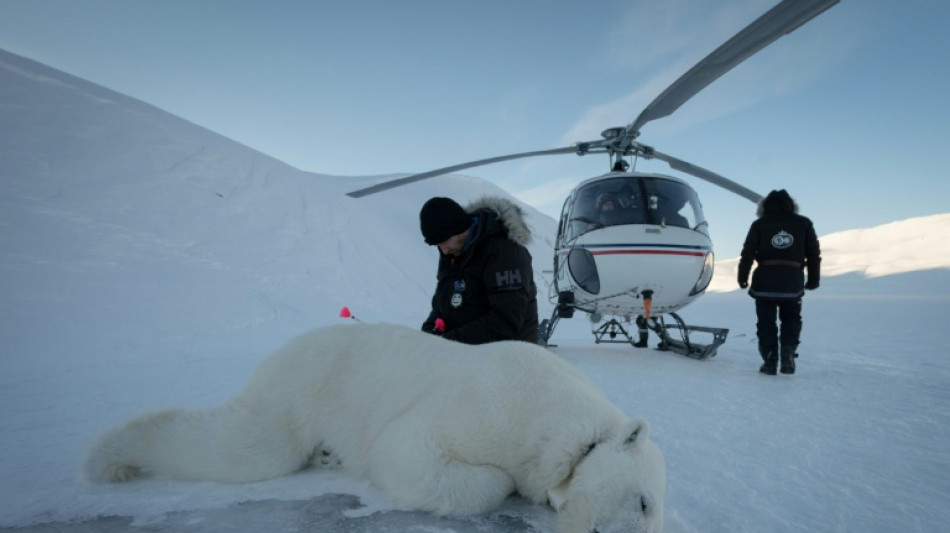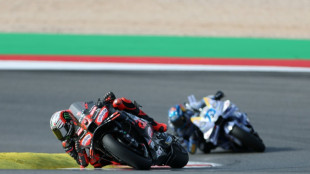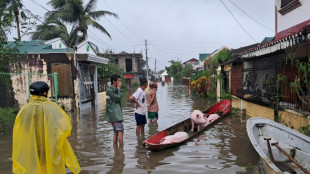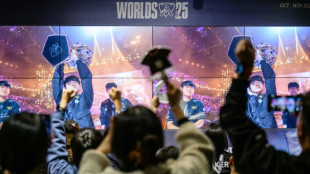
-
 BBC chief resigns after row over Trump documentary
BBC chief resigns after row over Trump documentary
-
Norris extends title lead in Sao Paulo, Verstappen third from pit-lane

-
 Norris wins in Sao Paulo to extend title lead over Piastri
Norris wins in Sao Paulo to extend title lead over Piastri
-
Man City rout Liverpool to mark Guardiola milestone, Forest boost survival bid

-
 Man City crush Liverpool to mark Guardiola's 1,000 match
Man City crush Liverpool to mark Guardiola's 1,000 match
-
Emegha fires Strasbourg past Lille in Ligue 1

-
 Howe takes blame for Newcastle's travel sickness
Howe takes blame for Newcastle's travel sickness
-
Pumas maul Wales as Tandy's first game in charge ends in defeat

-
 'Predator: Badlands' conquers N. American box office
'Predator: Badlands' conquers N. American box office
-
Liga leaders Real Madrid drop points in Rayo draw

-
 'Killed on sight': Sudanese fleeing El-Fasher recall ethnic attacks
'Killed on sight': Sudanese fleeing El-Fasher recall ethnic attacks
-
Forest boost survival bid, Man City set for crucial Liverpool clash

-
 US air travel could 'slow to a trickle' as shutdown bites: transport secretary
US air travel could 'slow to a trickle' as shutdown bites: transport secretary
-
Alcaraz makes winning start to ATP Finals

-
 'I miss breathing': Delhi protesters demand action on pollution
'I miss breathing': Delhi protesters demand action on pollution
-
Just-married Rai edges Fleetwood in Abu Dhabi playoff

-
 All aboard! Cruise ships ease Belem's hotel dearth
All aboard! Cruise ships ease Belem's hotel dearth
-
Kolo Muani drops out of France squad with broken jaw

-
 Israel receives remains believed to be officer killed in 2014 Gaza war
Israel receives remains believed to be officer killed in 2014 Gaza war
-
Dominant Bezzecchi wins Portuguese MotoGP

-
 Super Typhoon Fung-wong makes landfall in Philippines
Super Typhoon Fung-wong makes landfall in Philippines
-
Rai edges Fleetwood in Abu Dhabi playoff

-
 Scotland sweat on Russell fitness ahead of Argentina clash
Scotland sweat on Russell fitness ahead of Argentina clash
-
Faker's T1 win third back-to-back League of Legends world crown

-
 Former world champion Tanak calls time on rally career
Former world champion Tanak calls time on rally career
-
Ukraine scrambles for energy after Russian attacks

-
 Over 1 million evacuate as deadly Super Typhoon Fung-wong nears Philippines
Over 1 million evacuate as deadly Super Typhoon Fung-wong nears Philippines
-
Erasmus' ingenuity sets South Africa apart from the rest

-
 Asaji becomes first Japanese in 49 years to win Singapore Open
Asaji becomes first Japanese in 49 years to win Singapore Open
-
Vingegaard says back to his best after Japan win

-
 Philippines evacuates one million, woman dead as super typhoon nears
Philippines evacuates one million, woman dead as super typhoon nears
-
Ogier wins Rally Japan to take world title fight to final race

-
 A decade on, survivors and families still rebuilding after Paris attacks
A decade on, survivors and families still rebuilding after Paris attacks
-
Russia's Kaliningrad puts on brave face as isolation bites

-
 Philippines evacuates hundreds of thousands as super typhoon nears
Philippines evacuates hundreds of thousands as super typhoon nears
-
Syrian president arrives in US for landmark visit

-
 Cyndi Lauper, Outkast, White Stripes among Rock Hall of Fame inductees
Cyndi Lauper, Outkast, White Stripes among Rock Hall of Fame inductees
-
Fox shines in season debut as Spurs down Pelicans, Hawks humble Lakers

-
 New Zealand edge West Indies by nine runs in tense third T20
New Zealand edge West Indies by nine runs in tense third T20
-
Messi leads Miami into MLS playoff matchup with Cincinnati

-
 Ukraine scrambles for energy with power generation at 'zero'
Ukraine scrambles for energy with power generation at 'zero'
-
India mega-zoo in spotlight again over animal acquisitions

-
 Messi leads Miami into MLS Cup playoff matchup with Cincinnati
Messi leads Miami into MLS Cup playoff matchup with Cincinnati
-
Tornado kills six, injures 750 as it wrecks southern Brazil town

-
 Minnesota outlasts Seattle to advance in MLS Cup playoffs
Minnesota outlasts Seattle to advance in MLS Cup playoffs
-
Dental Crowns 101: A Beginner's Guide

-
 Marseille go top in Ligue 1 as Lens thrash Monaco
Marseille go top in Ligue 1 as Lens thrash Monaco
-
Fourteen-man South Africa fight back to beat France

-
 Atletico, Villarreal win to keep pressure on Liga giants
Atletico, Villarreal win to keep pressure on Liga giants
-
Chelsea down Wolves to ease criticism of Maresca's rotation policy


Polar bear biopsies to shed light on Arctic pollutants
With one foot braced on the helicopter's landing skid, a veterinarian lifted his air rifle, took aim and fired a tranquiliser dart at a polar bear.
The predator bolted but soon slumped into the snowdrifts, its broad frame motionless beneath the Arctic sky.
The dramatic pursuit formed part of a pioneering research mission in Norway's Svalbard archipelago, where scientists, for the first time, took fat tissue biopsies from polar bears to study the impact of pollutants on their health.
The expedition came at a time when the Arctic region was warming at four times the global average, putting mounting pressure on the iconic predators as their sea-ice habitat shrank.
"The idea is to show as accurately as possible how the bears live in the wild -- but in a lab," Laura Pirard, a Belgian toxicologist, told AFP.
"To do this, we take their (fatty) tissue, cut it in very thin slices and expose it to the stresses they face, in other words pollutants and stress hormones," said Pirard, who developed the method.
Moments after the bear collapsed, the chopper circled back and landed. Researchers spilled out, boots crunching on the snow.
One knelt by the bear's flank, cutting thin strips of fatty tissue. Another drew blood.
Each sample was sealed and labelled before the bear was fitted with a satellite collar.
Scientists said that while the study monitors all the bears, only females were tracked with GPS collars as their necks are smaller than their heads -- unlike males, who cannot keep a collar on for more than a few minutes.
- Arctic lab -
For the scientists aboard the Norwegian Polar Institute's research vessel Kronprins Haakon, these fleeting encounters were the culmination of months of planning and decades of Arctic fieldwork.
In a makeshift lab on the icebreaker, samples remained usable for several days, subjected to controlled doses of pollutants and hormones before being frozen for further analysis back on land.
Each tissue fragment gave Pirard and her colleagues insight into the health of an animal that spent much of its life on sea ice.
Analysis of the fat samples showed that the main pollutants present were per- and polyfluoroalkyl substances (PFAS) -- synthetic chemicals used in industry and consumer goods that linger in the environment for decades.
Despite years of exposure, Svalbard's polar bears showed no signs of emaciation or ill health, according to the team.
The local population has remained stable or even increased slightly, unlike parts of Canada, where the Western Hudson Bay group declined by 27 percent between 2016 and 2021, from 842 to 618 bears, according to a government aerial survey.
Other populations in the Canadian Arctic, including the Southern Beaufort Sea, have also shown long-term declines linked to reduced prey access and longer ice-free seasons.
Scientists estimate there are around 300 polar bears in the Svalbard archipelago and roughly 2,000 in the broader region stretching from the North Pole to the Barents Sea.
The team found no direct link between sea ice loss and higher concentrations of pollutants in Svalbard's bears. Instead, differences in pollutant levels came down to the bears' diet.
Two types of bears -- sedentary and pelagic -- feed on different prey, leading to different chemicals building up in their bodies.
- Changing diet -
With reduced sea ice, the bears' diets have already started shifting, researchers said. These behavioural adaptations appeared to help maintain the population’s health.
"They still hunt seals but they also take reindeer (and) eggs. They even eat grass (seaweed), even though that has no energy for them," Jon Aars, the head of the Svalbard polar bear programme, told AFP.
"If they have very little sea ice, they necessarily need to be on land," he said, adding that they spend "much more time on land than they used to... 20 or 30 years ago".
This season alone, Aars and his team of marine toxicologists and spatial behaviour experts captured 53 bears, fitted 17 satellite collars, and tracked 10 mothers with cubs or yearlings.
"We had a good season," Aars said.
The team's innovations go beyond biopsies. Last year, they attached small "health log" cylinders to five females, recording their pulse and temperature.
Combined with GPS data, the devices offer a detailed record of how the bears roam, how they rest and what they endure.
Polar bears were once hunted freely across Svalbard but since an international protection agreement in 1976, the population here has slowly recovered.
The team's findings may help explain how the bears' world is changing, and at an alarming rate.
As the light faded and the icebreaker's engines hummed against the vast silence, the team packed away their tools, leaving the Arctic wilderness to its inhabitants.
Ch.Havering--AMWN



